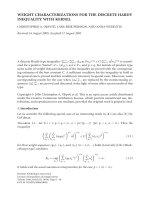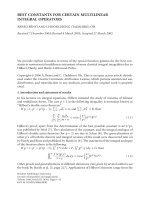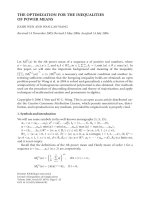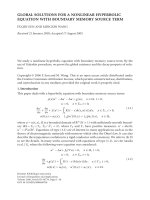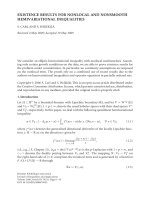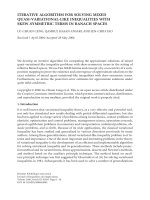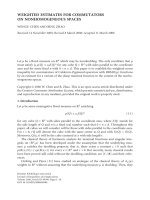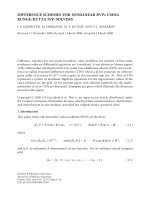Báo cáo hóa học: "BEST CONSTANTS FOR CERTAIN MULTILINEAR INTEGRAL OPERATORS" pptx
Bạn đang xem bản rút gọn của tài liệu. Xem và tải ngay bản đầy đủ của tài liệu tại đây (533 KB, 12 trang )
BEST CONSTANTS FOR CERTAIN MULTILINEAR
INTEGRAL OPERATORS
´
ARP
´
AD B
´
ENYI AND CHOONGHONG (TADAHIRO) OH
Received 7 December 2004; Revised 8 March 2005; Accepted 27 March 2005
We provide explicit formulas in terms of the special function gamma for the best con-
stants in nontensorial multilinear extensions of some classical integral inequalities due to
Hilbert, Hardy, and Hardy-Littlewood-P
´
olya.
Copyright © 2006
´
A. B
´
enyi and C. (Tadahiro) Oh. This is an open access article distrib-
uted under the Creative Commons Attribution License, which permits unrestricted use,
distribution, and reproduction in any medium, provided the ori ginal work is properly
cited.
1. Introduction and statement of results
In his lectures on integral equations, Hilbert initiated the study of maxima of bilinear
and multilinear forms. The case p
= 2 in the following inequality is nowadays known as
“Hilbert’s double series theorem.”
If p>1, p
= p/(p − 1),
∞
m=1
a
p
m
≤ A,and
∞
n=1
b
p
n
≤ B,then
∞
m=1
∞
n=1
a
m
b
n
m + n
≤ π csc
π
p
A
1/p
B
1/p
. (1.1)
Hilbert’s proof, apart from the determination of the best possible constant π csc(π/p),
was published by Weyl [7]. The calculation of the constant, and the integral analogue of
Hilbert’s double series theorem (for p
= 2) are due to Schur [6]. The generalizations to
other p
s of both the discrete and integral versions of this result were discovered later on
by Hardy and Riesz and published by Hardy in [4]. The statement of the integral analogue
of the theorem above is the following.
If p>1, p
= p/(p − 1),
∞
0
f
p
(x) dx ≤ F,
∞
0
g
p
(y)dy ≤ G,then
∞
0
f (x)g(y)
x + y
dxdy
≤ π csc
π
p
F
1/p
G
1/p
. (1.2)
Other proofs and generalizations in different directions were given by several authors; see
the book by Hardy et al. [5, page 227]. Applications of Hilbert’s theorem range from the
Hindawi Publishing Corporation
Journal of Inequalities and Applications
Volume 2006, Article ID 28582, Pages 1–12
DOI 10.1155/JIA/2006/28582
2 Best constants for certain multilinear integral operators
theory of analytic functions to results about the moments of real variable functions [5,
pages 236–247].
Let now K : R
m
+
→ R be a measurable kernel such that
C
m
=
∞
0
···
∞
0
K
y
1
, , y
m
y
−1/p
1
1
···y
−1/p
m
m
dy
1
···dy
m
< ∞; (1.3)
here, 1 <p
1
, p
2
, , p
m
< ∞ are some arbitrary (fixed) indices. The m-linear operator T is
defined via
T
f
1
, , f
m
(x) =
∞
0
···
∞
0
K
y
1
, , y
m
f
1
xy
1
···
f
m
xy
m
dy
1
···dy
m
, (1.4)
where x>0and f
1
, , f
m
are measurable functions on R
+
= [0,∞). Note that T is in fact
an integral operator having a homogeneous kernel
K of degree −m,
T
f
1
, , f
m
(x) =
∞
0
···
∞
0
K
x, y
1
, , y
m
f
1
y
1
···
f
m
y
m
dy
1
···dy
m
, (1.5)
where
K(x, y
1
, , y
m
) = x
−m
K(x
−1
y
1
, ,x
−1
y
m
). Condition (1.3)canberewrittenas
C
m
=
∞
0
···
∞
0
K
1, y
1
, , y
m
y
−1/p
1
1
···y
−1/p
m
m
dy
1
···dy
m
< ∞. (1.6)
We remark also that, if p
0
> 1issuchthat1/p
0
+1/p
1
+ ···+1/p
m
= 1, then
C
m
=
∞
0
···
∞
0
K
x,1, y
2
, , y
m
x
−1/p
0
y
−1/p
2
2
···y
−1/p
m
m
dxdy
2
···dy
m
. (1.7)
In particular, (1.6)and(1.7)implythat,if
K is symmetric with respect to the variables
x, y
1
, , y
m
,thenC
m
is a symmetric expression of the indices p
0
, p
1
, , p
m
.
The goal of this paper is twofold: to give a proof of the multilinear extension of the
integral inequality (1.2) and to provide some interesting applications of this result.
Theorem 1.1. Let m
≥ 1 and 1 <p, p
1
, , p
m
< ∞ be such that 1/p
1
+1/p
2
+ ···+1/p
m
=
1/p. Then
T
f
1
, , f
m
L
p
(R
+
)
≤ C
m
f
1
L
p
1
(R
+
)
···
f
m
L
p
m
(R
+
)
, (1.8)
where C
m
is the constant defined by (1.3)or(1.6). Moreover, if K(y
1
, , y
m
) ≥ 0 for all
y
1
, , y
m
≥ 0,thentheconstantC
m
is the best possible in (1.8).
A less general version of Theorem 1.1, which assumes the kernel to be a positive func-
tion and which does not determine the best constant, can be found in [5]. There are
many proofs of inequality (1.8). For the sake of completeness, we will recall one w hich
to us seems to be the easiest and which is inspired by an idea of Schur [6] in the linear
case; see also [5, page 230]. The determination of the best constant, however, is much
more interesting. In this work, a strong emphasis is placed on obtaining explicit formulas,
in terms of the special gamma function Γ, of the best constants in multilinear extensions
of certain inequalities due to Hilbert, Hardy, and Hardy-Littlewood-P
´
olya which do not
´
A. B
´
enyi and C. (Tadahiro) Oh 3
seem to be in the literature. These formulas are presented in Section 3.Weprovethe
main result, Theorem 1.1, in the following section. The elementary, yet nontr ivial, proof
is a nice application of the Dominated Convergence theorem.
Remark 1.2. An alternate way of finding an upper bound for the norm of a positive mul-
tilinear operator is via the so called multilinear Schur test in the work of Grafakos and
Tor res [2, Theorem 1]. In particular, for an m-linear operator T with positive and sym-
metric kernel on R
m
+
, the multilinear Schur test gives the following implication.
If for all B>A>0, there exist measurable functions u
1
, ,u
m
,w on R
+
with 0 <
u
1
, ,u
m
, w<∞ a.e. such that
T
u
p
1
1
, ,u
p
m
m
≤
Bw
p
a.e., (1.9)
then T is a bounded operator from L
p
1
(R
+
) ×···×L
p
m
(R
+
)intoL
p
(R
+
), with norm less
than or equal to A.
In the case of the multilinear nontensorial extension of the Hilbert operator P
¬⊗
(see
Section 3.1 for its definition), it was shown in [2] that an appropriate choice of the func-
tions u
1
, ,u
m
, w gives in fact equality in (1.9). Furthermore, it is easy to see that the same
choice of weights u
j
(y
j
) = y
−1/p
j
p
j
j
, w(x) = x
−1/pp
,1≤ j ≤ m, gives equality in (1.9)for
all m-linear operators T of the form (1.4). In this case B
= C
m
,whereC
m
is defined by
(1.3). Therefore, by the implication above, we see that the operator norm
T≤C
m
.We
would like to point out, however, that in order to show
T=C
m
one needs to either
trace back where equality holds in the inequalities proving the main result of [2]orgo
through a similar computation to the one presented here in the next section.
2. Proof of Theorem 1.1
We let g
∈ L
p
(R
+
), 1/p+1/p
= 1 and denote by ·,· the dual (L
p
,L
p
)pairing.For
simplicity, we will write L
p
for L
p
(R
+
). Note that, for i = 1, ,m,
∞
0
| f
i
(xy
i
)|
p
i
dx =
y
−1
i
∞
0
| f
i
(x)|
p
i
dx. Using this fact and H
¨
older’s inequality, we obtain the following se-
quence of inequalities:
T
f
1
, , f
m
,g
≤
∞
0
···
∞
0
K
y
1
, , y
m
∞
0
g(x)
f
1
xy
1
···
f
m
xy
m
dxdy
1
···dy
m
≤
∞
0
···
∞
0
K
y
1
, , y
m
)
g
L
p
m
i=1
∞
0
f
i
xy
i
p
i
dx
1/p
i
dy
1
···dy
m
= C
m
g
L
p
f
1
L
p
1
···
f
m
L
p
m
.
(2.1)
This proves the first part of our theorem.
For the second part, we will show that if the kernel K is nonnegative, then the operator
norm
T of T is exactly C
m
.Forn a positive integer and i = 1, ,m, we define the
4 Best constants for certain multilinear integral operators
sequences of functions g
n
, f
i,n
by
g
n
(x) = x
−1/p
+1/p
n
χ
[0,1]
(x), f
i,n
(x) = x
−1/p
i
+1/p
i
n
χ
[0,1]
(x) . (2.2)
Clearly,
g
n
p
L
p
=f
i,n
p
i
L
p
i
=g
n
L
p
f
1,n
L
p
1
···f
m,n
L
p
m
= n.Wehave
T
f
1,n
, , f
m,n
,g
n
=
1
0
x
−1/p
+1/p
n
∞
0
···
∞
0
K
y
1
, , y
m
f
1,n
xy
1
···
f
m,n
xy
m
dy
1
···dy
m
dx
=
1
0
x
−1/p
+1/p
n
1/x
0
···
1/x
0
K
y
1
, , y
m
m
i=1
xy
i
−1/p
i
+1/p
i
n
dy
1
···dy
m
dx
=
1
0
x
−1+1/n
1/x
0
···
1/x
0
K
y
1
, , y
m
m
i=1
y
−1/p
i
+1/p
i
n
i
dy
1
···dy
m
dx
=−n
∞
1
x
−1/n
x
0
···
x
0
K
y
1
, , y
m
m
i=1
y
−1/p
i
+1/p
i
n
i
dy
1
···dy
m
dx
= n
1
0
···
1
0
K
y
1
, , y
m
m
i=1
y
−1/p
i
+1/p
i
n
i
dy
1
···dy
m
+
m
i=1
I
i
,
(2.3)
or
T
f
1,n
, , f
m,n
,g
n
g
n
L
p
f
1,n
L
p
1
···
f
m,n
L
p
m
=
1
0
···
1
0
K
y
1
, , y
m
m
i=1
y
−1/p
i
+1/p
i
n
i
dy
1
···dy
m
+
m
i=1
I
i
/n.
(2.4)
For i
= 1, ,m,wehavedenoted
I
i
= n
∞
1
y
−1/n
i
y
i
0
···
y
i
0
K
y
1
, , y
m
m
j=1
y
−1/p
j
+1/p
j
n
j
dy
1
···
dy
i
···dy
m
dy
i
; (2.5)
here,
dy
i
means that we do not integrate with respect to the variable y
i
. In the transition
from the fourth to the fifth line in the sequence of equalities above we made the change of
variables x
→ 1/x. The last equality follows from integr ation by parts and the observation
that, if we let
S
z
1
, ,z
m
=
z
1
0
···
z
m
0
K
y
1
, , y
m
m
i=1
y
−1/p
i
+1/p
i
n
i
dy
1
···dy
m
, (2.6)
´
A. B
´
enyi and C. (Tadahiro) Oh 5
then
d
dx
S(x, ,x)
=
m
i=1
∂S
∂z
i
(x, ,x) =
m
i=1
x
0
···
x
0
K
y
1
, ,
(i)
x , , y
m
x
−1/p
i
+1/p
i
n
×
j=i
y
−1/p
j
+1/p
j
n
j
dy
1
···
dy
i
···dy
m
,
(2.7)
where the upper index (i) means that x replaces the variable y
i
in the ith position. Let
now D
i
denote the domain of integration in the integral I
i
above, that is,
D
i
=
y
1
, , y
m
∈
R
m
+
:1≤ y
i
< ∞,0≤ y
j
≤ y
i
, j = i
. (2.8)
Taking into account that 1/p
1
+ ···+1/p
m
= 1/p, we can bound the integrand of I
i
/n on
D
i
as follows:
y
−1/n
i
K
y
1
, , y
m
m
j=1
y
−1/p
j
+1/p
j
n
j
≤ y
−1/n+1/p
1
n+···+1/p
m
n
i
K
y
1
, , y
m
m
j=1
y
−1/p
j
j
= y
−1/p
n
i
K
y
1
, , y
m
m
j=1
y
−1/p
j
j
≤ K
y
1
, , y
m
m
j=1
y
−1/p
j
j
.
(2.9)
Also, on [0,1]
m
we obviously have
K
y
1
, , y
m
m
j=1
y
−1/p
j
+1/p
j
n
j
≤ K
y
1
, , y
m
m
j=1
y
−1/p
j
j
. (2.10)
Now, assumption (1.3)onthekernelK allows us to use the Dominated Convergence
theorem to infer that
lim
n→∞
I
i
/n =
∞
1
y
i
0
···
y
i
0
K
y
1
, , y
m
m
j=1
y
−1/p
j
j
dy
1
···dy
m
,
lim
n→∞
1
0
···
1
0
K
y
1
, , y
m
m
j=1
y
−1/p
j
+1/p
j
n
j
dy
1
···dy
m
=
1
0
···
1
0
K
y
1
, , y
m
m
j=1
y
−1/p
j
j
dy
1
···dy
m
.
(2.11)
Furthermore, we have
[0,1]
m
m
i=1
D
i
=
R
m
+
, (2.12)
and for i, j
= 1, ,m, any of the intersection sets [0,1]
m
D
i
, D
i
D
j
, i = j, has Lebesgue
measure 0 in R
m
. Consequently, (2.4), (2.11)implythat
T=lim
n→∞
T
f
1,n
, , f
m,n
,g
n
g
n
L
p
f
1,n
L
p
1
···
f
m,n
L
p
m
= C
m
. (2.13)
The proof is now complete.
6 Best constants for certain multilinear integral operators
3. Applications
In this section we wish to revisit some important inequalities due to Hilbert, Hardy-
Littlewood-P
´
olya, and Hardy. We will discuss the possible multilinear extensions of these
inequalities and provide formulas for the best constants in a closed form via the gamma
function. The formulas we present here do not seem to be in the literature. Let us first
recall a few basic facts about the gamma and beta functions. For more details and further
references on special functions, see the book by Andrews et al. [1]. For a complex number
z with Rez>0define
Γ(z)
=
∞
0
t
z−1
e
−t
dt. (3.1)
It follows from the definition that the gamma function Γ(z) is analytic in the right half-
plane Rez>0. Two fundamental properties of the gamma function are that
Γ(z +1)
= zΓ(z), Γ(z)Γ(1 − z) =
π
sin(πz)
. (3.2)
In particular, we also have Γ(n)
= (n − 1)! for all positive integers n. The second formula
above is known under the name of Euler’s reflection formula. Next we define the beta
function. For z and w complex numbers with positive real parts,
B(z, w)
=
1
0
t
z−1
(1 − t)
w−1
dt. (3.3)
We have the following relationship between the gamma and beta functions:
B(z, w)
=
Γ(z)Γ(w)
Γ(z + w)
. (3.4)
3.1. Hilbert’s operator. Consider the linear operator
Pf(x) =
∞
0
f (y)
x + y
dy (3.5)
with the kernel
K
(1)
(x, y) = 1/(x + y) which is symmetric in the variables x, y and homo-
geneous of degree
−1. By duality, we see that the integral analogue of Hilbert’s theorem
(1.2) is equivalent to the best constant inequality
Pf
L
p
(R
+
)
≤ π csc
π
p
f
L
p
(R
+
)
. (3.6)
The operator P is usually referred to as Hilbert’s operator and inequality (3.6)asHilbert’s
inequality. On our quest for multilinear extensions of (3.6) we would like to preserve the
features of the operator P. In par ticular, we wish to extend its kernel
K
(1)
to kernels
K
(m)
that fit the framework of our main result, Theorem 1.1. One such extension is provided
´
A. B
´
enyi and C. (Tadahiro) Oh 7
by the m-linear operator
P
⊗
f
1
, , f
m
(x) =
∞
0
···
∞
0
f
1
y
1
···
f
m
y
m
x + y
1
)···
x + y
m
dy
1
···dy
m
(3.7)
having the kernel
K
(m)
⊗
=
1
x + y
1
···
x + y
m
=
m
i=1
K
(1)
x, y
i
. (3.8)
Although
K
(m)
⊗
is symmetric x, y
1
, , y
m
and homogeneous of degree −m, and thus it
preserves the properties satisfied by its one dimensional counterpart
K
(1)
, the multilin-
ear extension P
⊗
is not very interesting due to its tensorial char acter. Throughout the
remaining of this paper, we let 1 <p, p
1
, , p
m
< ∞ be such that 1/p= 1/p
1
+ ···1/p
m
,
and denote by p
0
= p
the dual exponent of p.WewillalsowriteL
p
for L
p
(R
+
). Since
P
⊗
f
1
, , f
m
=
(P ⊗···⊗P)
f
1
, , f
m
=
P( f
1
)···P
f
m
, (3.9)
using H
¨
older’s inequality and (3.6), we obviously have
P
⊗
f
1
, , f
m
L
p
≤ π
m
m
i=1
csc
π
p
i
f
1
L
p
1
···
f
m
L
p
m
. (3.10)
Theconstantontheright(theoperatornorm
P
⊗
of P
⊗
) is the best possible.
A much more interesting situation arises when we consider the nontensorial extension
P
¬⊗
f
1
, , f
m
(x) =
∞
0
···
∞
0
f
1
y
1
···
f
m
y
m
x + y
1
+ ···+ y
m
m
dy
1
···dy
m
(3.11)
having the (symmetr ic in variables x, y
1
, , y
m
and homogeneous of degree −m)kernel
K
(m)
¬⊗
=
1
x + y
1
+ ···+ y
m
m
. (3.12)
Noting that
K
(m)
¬⊗
≤
K
(m)
⊗
, we know that the operator P
¬⊗
is bounded from L
p
1
×···×L
p
m
into L
p
. Nevertheless, the a priori constant P
⊗
is not the best possible in this case.
Claim 3.1. The following best constant inequality holds:
P
¬⊗
f
1
, , f
m
L
p
≤
1
(m − 1)!
m
i=0
Γ
1
p
i
f
1
L
p
1
···
f
m
L
p
m
. (3.13)
Recall that, due to the homogeneity and symmetry in the variables x, y
1
, , y
m
of
K
(m)
¬⊗
,
the formula that computes the norm of the cor responding operator defined by (3.11)
must be a symmetric expression in p
0
, p
1
, , p
m
; see the comments following (1.6). This
is indeed the case in Claim 3.1. Observe that the best “tensorial” constant
P
⊗
is sym-
metric only in p
1
, p
2
, , p
m
, in general.
8 Best constants for certain multilinear integral operators
Proof. By Theorem 1.1, the best constant is given by
C
m
=
∞
0
···
∞
0
1+y
1
+ ···+ y
m
−m
y
−1/p
1
1
···y
−1/p
m
m
dy
1
···dy
m
. (3.14)
Let us denote the integral on the right by I
m
(m,1/p
1
, ,1/p
m
). By making the change of
variables y
m
= (1+ y
1
+ ···+ y
m−1
)t and integrating first with respect to dt,weget
I
m
m,1/p
1
, ,1/p
m
=
∞
0
(1 + t)
−m
t
−1/p
m
dtI
m−1
m − 1/p
m
,1/p
1
, ,1/p
m−1
. (3.15)
Observe that, if we make the change of variables t +1
= 1/s,
∞
0
(1 + t)
α
t
β
dt =
1
0
s
−α−β−2
(1 − s)
β
ds = B(−α − β − 1,β +1). (3.16)
Therefore, if we recall the relationship between the beta and gamma functions, we obtain
∞
0
(1 + t)
−m
t
−1/p
m
dt =
Γ
m − 1/p
m
Γ
1/p
m
Γ(m)
,
I
m
m,1/p
1
, ,1/p
m
=
Γ
m − 1/p
m
Γ
1/p
m
Γ(m)
I
m−1
m − 1/p
m
,1/p
1
, ,1/p
m−1
.
(3.17)
By a simple induction argument, we obtain from this recurrence that
I
m
m,1/p
1
, ,1/p
m
=
Γ
m − 1/p
m
−···−1/p
1
Γ
1/p
m
···
Γ
1/p
1
Γ(m)
. (3.18)
Due to the relation on the exponents, the latter equality simplifies exactly to
C
m
=
1
(m − 1)!
m
i=0
Γ
1
p
i
. (3.19)
Remark 3.2. One can construct other multilinear extensions of P. For example, consider
the m-linear operator
P
m
f
1
, , f
m
(x) =
∞
0
···
∞
0
f
1
y
1
···
f
m
y
m
x + y
1
···y
m
m
dy
1
···dy
m
. (3.20)
For m
= 1weclearlyrecoverP from P
m
. Note, however, that the kernel of P
m
is not sym-
metric with respect to x, y
1
, , y
m
, and we do not have anymore the a priori boundedness
oftheoperatoronproductsofLebesguespaces,sinceP
m
and P
⊗
are not comparable. As
such, the operator P
m
does not fall under the scope of our main result, Theorem 1.1.For
the remainder of the paper, we will avoid any further discussion about multilinear opera-
tors that are arbitrary extensions (i.e., which do not preserve the features) of the classical
linear operators considered.
´
A. B
´
enyi and C. (Tadahiro) Oh 9
3.2. Hardy-Littlewood-P
´
olya’s operator. We let Q denote Hardy-Littlewood-P
´
olya’s lin-
ear operator defined by
Qf(x)
=
∞
0
f (y)
max(x, y)
dy. (3.21)
Its m-linear nontensorial extension is
Q
¬⊗
f
1
, , f
m
(x) =
∞
0
···
∞
0
f
1
y
1
···
f
m
y
m
max
x, y
1
, , y
m
m
dy
1
···dy
m
. (3.22)
Claim 3.3. The following best constant inequality holds:
Q
¬⊗
f
1
, , f
m
L
p
≤
m
i=0
m
j=0, j=i
p
j
f
1
L
p
1
···
f
m
L
p
m
. (3.23)
Proof. With the notation in the proof of Theorem 1.1,wecandecomposeR
m
+
into the
union [0,1]
m
(
m
i
=1
D
i
) so that the interiors of t he sets in this union are pariwise disjoint.
Furthermore, the best constant in the inequality we want to prove is
C
m
=
∞
0
···
∞
0
max
1, y
1
, , y
m
−m
y
−1/p
1
1
···y
−1/p
m
m
dy
1
···dy
m
=
[0,1]
m
y
−1/p
1
1
···y
−1/p
m
m
dy
1
···dy
m
+
m
i=1
J
i
,
(3.24)
where
J
i
=
∞
1
y
i
0
···
y
i
0
y
−1/p
1
1
···y
−m−1/p
i
i
···y
−1/p
m
m
dy
1
···
dy
i
···dy
m
dy
i
. (3.25)
Now,
[0,1]
m
y
−1/p
1
1
···y
−1/p
m
m
dy
1
···dy
m
=
m
j=1
y
1−1/p
j
j
1 − 1/p
j
|
1
0
=
m
j=1
p
j
(3.26)
and (recall that p
0
= p)
J
i
=
∞
1
y
−m−1/p
i
i
m
j=1, j=i
y
1−1/p
j
j
1 − 1/p
j
|
y
i
0
dy
i
=
m
j=1, j=i
p
j
∞
1
y
−1−1/p
1
−···−1/p
m
i
dy
i
=
m
j=1, j=i
p
j
y
−1/p
1
−···−1/p
m
i
−1/p
1
−···−1/p
m
|
∞
1
=
m
j=0, j=i
p
j
.
(3.27)
By summing up, we obtain the desired result.
10 Best constants for certain multilinear integral operators
In particular, for m
= 1, we recover the best constant in the (L
p
,L
p
) inequality satisfied
by the operator Q, C
1
= p + p
= p
2
/(p − 1); see [5, page 254]. Furthermore, for the m-
linear tensorial extension of Q,
Q
⊗
f
1
, , f
m
(x) =
∞
0
···
∞
0
f
1
y
1
···
f
m
y
m
max
x, y
1
···
max
x, y
m
dy
1
···dy
m
(3.28)
the best constant inequality is
Q
⊗
f
1
, , f
m
L
p
≤
m
i=1
p
2
i
p
i
− 1
f
1
L
p
1
···
f
m
L
p
m
. (3.29)
3.3. Hardy’s operator. In his attempts to simplify the proofs known at the time of
Hilbert’s double series theorem, Hardy introduced in [3]theoperator
Rf(x)
=
1
x
x
0
f (y)dy (3.30)
and proved that it is bounded from L
p
into L
p
with best constant p/(p − 1). Unlike the
kernels of the operators P, Q considered before, the ker nel
k
(1)
(x, y) = (1/x)χ
[0,x]
(y)ofR
is not symmetric with respect to the variables x, y (to emphasize this difference, we use
now the lower case letter k). Here, χ
I
denotes the characteristic function of the set I.The
m-linear tensorial extension
R
⊗
f
1
, , f
m
(x) =
1
x
m
x
0
···
x
0
f
1
y
1
···
f
m
y
m
dy
1
···dy
m
(3.31)
is then bounded from L
p
1
×··· ×L
p
m
into L
p
, and the best constant is
m
i
=1
p
i
/(p
i
−
1). Note that the kernel
k
(m)
⊗
of R
⊗
is still positive and homogeneous of deg ree −m,
as required in the hypothesis of Theorem 1.1. In our search for an appropriate non-
tensorial multilinear extension of R, we observed that we could also write
k
(1)
(x, y) =
(1/x)χ
[0,1]
(y/x) = (1/x)χ
[1+y/x,∞)
(2). This simple observation has suggested that we de-
fine the nontensorial extension via
R
¬⊗
f
1
, , f
m
(x) =
1
x
m
∞
0
···
∞
0
χ
[0,x]
y
1
+ ···+ y
m
f
1
y
1
···
f
m
y
m
dy
1
···dy
m
.
(3.32)
It is worth noting that, as in the prev ious examples, the kernel of the nontensorial ex-
tension satisfies
k
(m)
¬⊗
≤
k
(m)
⊗
. We therefore have the a priori boundedness of R
¬⊗
from
L
p
1
×···×L
p
m
into L
p
. However, since
k
(m)
¬⊗
is symmetric in the variables y
1
, , y
m
but
not in x, we expect the operator norm of the nontensorial extension to be symmetric in
p
1
, p
m
but not in p
0
= p
(the index that “corresponds” to x).
Claim 3.4. The following best constant inequality holds:
R
¬⊗
f
1
, , f
m
L
p
≤
m
i
=1
Γ
1/p
i
Γ
m +1/p
0
f
1
L
p
1
···
f
m
L
p
m
. (3.33)
´
A. B
´
enyi and C. (Tadahiro) Oh 11
Proof. By Theorem 1.1, the best constant is given by
C
m
=
∞
0
···
∞
0
χ
[0,1]
y
1
+ ···+ y
m
y
−1/p
1
1
···y
−1/p
m
m
dy
1
···dy
m
=
1
0
1−y
1
0
···
1−y
1
−···−y
m−1
0
y
−1/p
1
1
···y
−1/p
m
m
dy
m
···dy
1
= p
m
1
0
1−y
1
0
···
1−
m−2
k
=1
y
k
0
y
−1/p
1
1
···y
−1/p
m−1
m−1
1 −
m−1
k=1
y
k
1/p
m
dy
m−1
···dy
1
.
(3.34)
In the last integral, we make the substitution y
m−1
= t
m−1
(1 −
m−2
k
=1
y
k
)andintegratefirst
with respect to dt
m−1
. This allows us to simplify to an integral over only m − 2variables
multiplied by the integral in t
m−1
,
1
0
t
−1/p
m−1
m−1
(1 − t
m−1
)
1/p
m
dt
m−1
= B(1/p
m
,1 + 1/p
m
).
More precisely, we have
C
m
= p
m
Γ
1/p
m−1
Γ
1+1/p
m
Γ
1+1/p
m−1
+1/p
m
×
1
0
1−y
1
0
···
1−
m−3
k
=1
y
k
0
y
−1/p
1
1
···y
−1/p
m−2
m−2
1 −
m−2
k=1
y
k
1/p
m−1
+1/p
m
dy
m−2
···dy
1
.
(3.35)
Since, p
m
Γ(1 + 1/p
m
) = Γ(1/p
m
), by letting successively y
m−2
= t
m−2
(1 −
m−3
k
=1
y
k
), ,
y
2
= t
1
(1 − y
1
) and integrating with respect to dt
m−2
, ,dt
1
respectively, we obtain
C
m
=
m
i
=1
Γ
1/p
i
Γ
1+
m
i
=1
1/p
i
. (3.36)
Since,
m
i
=1
1/p
i
= m− 1/p, the desired result follows.
Remark 3.5. The integr al inequalities we considered have corresponding discrete ver-
sions. For example, the m-linear discrete versions of Hilbert’s and Hardy-Littlewood-
P
´
olya’s inequalities are, respectively,
∞
k=1
∞
k
1
=1
···
∞
k
m
=1
a
k
a
k
1
···a
k
m
k + k
1
+ ···+ k
m
m
≤ C
m
(
∞
k=1
a
p
k
)
1/p
m
j=1
∞
k
j
=1
a
p
j
k
j
1/p
j
,
∞
k=1
∞
k
1
=1
···
∞
k
m
=1
a
k
a
k
1
···a
k
j
max
k,k
1
,··· ,k
m
m
≤ C
m
∞
k=1
a
p
k
1/p
m
j=1
∞
k
j
=1
a
p
j
k
j
1/p
j
.
(3.37)
The constants C
m
and C
m
are the ones obtained in Claims 3.1 and 3.3, respectively. The
proofs of the discrete versions follow from an appropri ate discrete analogue of Theorem
1.1, but we will not pursue such a result here; the interested reader is referred to [5,page
232] for further details.
12 Best constants for certain multilinear integral operators
Acknowledgment
We are indebted to the anonymous referees for the many valuable suggestions that im-
proved the quality of our presentation.
References
[1] G.E.Andrews,R.Askey,andR.Roy,Special Functions, Encyclopedia of Mathematics and Its
Applications, vol. 71, Cambridge University Press, Cambridge, 1999.
[2] L. Grafakos and R. H. Torres, A multilinear Schur test and multiplier operators, Journal of Func-
tional Analysis 187 (2001), no. 1, 1–24.
[3] G.H.Hardy,Note on a theorem of Hilbert, Mathematische Zeitschrift 6 (1920), no. 3-4, 314–317.
[4]
, Note on a theorem of Hilbert concerning series of positive terms, Proceedings of the Lon-
don Mathematical Society 23 (1925), 45–46.
[5] G.H.Hardy,J.E.Littlewood,andG.P
´
olya, Inequalities, 2nd ed., Cambridge University Press,
Cambridge, 1952.
[6] I. Schur, Bemerkungen z ur Theorie der beschr
¨
ankten Bilinearformen mit unendlich vielen
ver
¨
anderlichen,Journalf
¨
ur die Reine und Angewandte Mathematik 140 (1911), 1–28 (German).
[7] H. Weyl, Sing
¨
ulare Integralgleichungen mit besonderer Ber
¨
ucksichtigung des Fourierschen Inte-
graltheorems, Inaugural-Dissertation, Gottingen, 1908.
´
Arp
´
ad B
´
enyi: Depar tment of Mathematics, 516 High Street, Western Washington University,
Bellingham, WA 98225-9063, USA
E-mail address:
Choonghong (Tadahiro) Oh: Department of Mathematics and Statistics, Lederle GRT,
University of Massachusetts, Amherst, MA 01003-9305, USA
E-mail address:


